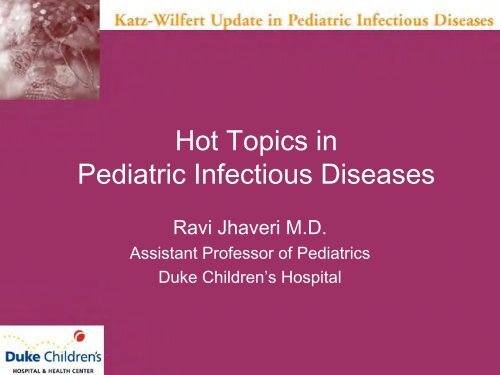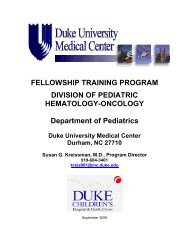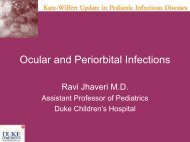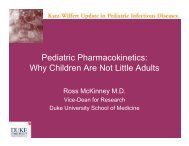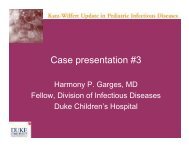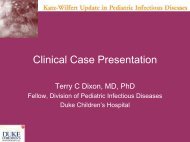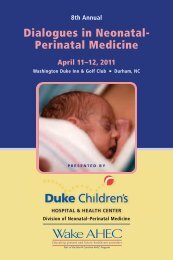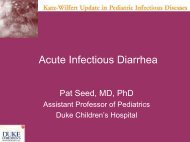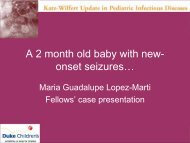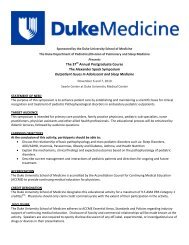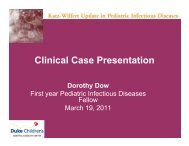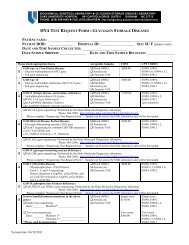Hot Topics in Pediatric Infectious Diseases - Duke Pediatrics Intranet
Hot Topics in Pediatric Infectious Diseases - Duke Pediatrics Intranet
Hot Topics in Pediatric Infectious Diseases - Duke Pediatrics Intranet
Create successful ePaper yourself
Turn your PDF publications into a flip-book with our unique Google optimized e-Paper software.
Time for“change you can believe <strong>in</strong>”….
Live attenuated Flu vacc<strong>in</strong>e• FluMist (MedImmune)• Attenuated <strong>in</strong>fluenza stra<strong>in</strong>s that have been adapted togrow well at lower temperatures <strong>in</strong> the nose• Intranasal delivery <strong>in</strong>duces local immunity to preventsevere lower respiratory disease• Approved for ages 2-49 years old– 2-8 years need 2 doses if never vacc<strong>in</strong>ated or only 1 if vacc<strong>in</strong>atedaga<strong>in</strong>st flu before, >9 years need 1 dose• Still only <strong>in</strong>dicated for healthy patients– High risk patients excluded
New data on FluMist• Study compar<strong>in</strong>g CAIV vs. TIV <strong>in</strong> children6-71 months <strong>in</strong> 2002-3 season– Over 1000 kids <strong>in</strong> each group– 2 doses of either for everyone– Followed kids for ILI, confirmed flu cases andadverse events <strong>in</strong>clud<strong>in</strong>g wheezeAshkenazi et al, Pediatr Infect Dis J 2006;25: 870–879
New data on FluMistAshkenazi et al, Pediatr Infect Dis J 2006;25: 870–879
More data on FluMist• Study compar<strong>in</strong>g CAIV vs. TIV <strong>in</strong> children6-17 years old with asthma <strong>in</strong> 2002-3season– Over 1000 kids <strong>in</strong> each group– 1 dose of either for everyone– Followed kids for ILI, confirmed flu cases andpulmonary function <strong>in</strong>clud<strong>in</strong>g wheez<strong>in</strong>gFlem<strong>in</strong>g et al, Pediatr Infect Dis J 2006;25: 860–869
More data on FluMistFlem<strong>in</strong>g et al, Pediatr Infect Dis J 2006;25: 860–869
More data on FluMist• No significant differences <strong>in</strong> asthmaexacerbations, hospitalizations, antibioticuse, etc.Flem<strong>in</strong>g et al, Pediatr Infect Dis J 2006;25: 860–869
Other considerations…• 2002-03 was a year when the vacc<strong>in</strong>e was apretty good match for the circulat<strong>in</strong>g stra<strong>in</strong>s, andCAIV was still twice as good as TIV• I expect when data is available for the yearswhen the vacc<strong>in</strong>e was not matched as well,CAIV will be even better• Recent study shows CAIV safe <strong>in</strong> <strong>in</strong>fants asyoung as 6 weeks (Vesikari et al, <strong>Pediatric</strong>s 2008; 121:e568-e573)
What to do for now?• Issue right now is cost and coverage– Fully approved down to 2 years old– Fridge stored version approved (CAIV vs. LAIV)• Depend<strong>in</strong>g on your population,– Consider keep<strong>in</strong>g some doses on hand for yourrecurrent <strong>in</strong>fection kids (AOM, s<strong>in</strong>usitis, pneumonias)– For anyone that is will<strong>in</strong>g to pay for it• No thimerosal <strong>in</strong> this product
Flu Vacc<strong>in</strong>e coverage <strong>in</strong> kids 2006-7• Rate for 24-59 montholds nationally–
Current Influenza Activityhttp://www.cdc.gov/flu/weekly/http://www.epi.state.nc.us/epi/gcdc/flu.html
Ripped from the headl<strong>in</strong>es….
An Epidemic that progresses…• 16 y.o previously healthy female presents to PMDwith fever, fatigue. PE at the time is unremarkable.• Over the course of 24 hours, the patient developsrespiratory failure, hemodynamic <strong>in</strong>stability andmultisystem organ failure.• She is transferred to <strong>Duke</strong> PICU where she is foundto have an overwhelm<strong>in</strong>g pneumonia. Maximalsupportive and antimicrobial therapy are <strong>in</strong>stitutedbut the efforts are futile.Life support is withdrawn.
An Epidemic that progresses…• Outside blood culture grows CA-MRSA…
CA-MRSA• Community Acquired (or Associated)Methicill<strong>in</strong> Resistant Staphylococcus aureus• First noticed <strong>in</strong> the early 2000s as caus<strong>in</strong>gfrequent sk<strong>in</strong>-soft tissue <strong>in</strong>fections as well asfatal necrotiz<strong>in</strong>g pneumonias• Conta<strong>in</strong>s a shorter cassette for antibioticresistance than Hospital MRSA so it morefreely transmits to other bacteria
CA-MRSA• MRSA is <strong>in</strong> the news on a weekly, maybe evennightly basis• Confusion and widespread panic is be<strong>in</strong>g exploitedby news and advertisers• We as physicians need to emphasize facts:• CA-MRSA is <strong>in</strong> the community be<strong>in</strong>g spread• All the hand sanitizer <strong>in</strong> the world is not go<strong>in</strong>g to stop it!• While I agree with measures to help with hospital hygiene, thehorse is out of the barn– We need better science, better drugs and best, a vacc<strong>in</strong>e
CA-MRSA: better science• A recent study <strong>in</strong> the Proceed<strong>in</strong>gs of theNational Academy of Science attempts tobetter understand the genetic evolutionand diversity of CA-MRSA to help answersome key questions– When and how did these isolates evolve?– How can we better understand thephenotypic/virulence differences that we see?– WARNING: These next slides will <strong>in</strong>volve basic science..I will go slow and hold your hand through this….
CA-MRSA: better scienceKennedy et al, PNAS Jan 2008
CA-MRSA: better scienceKennedy et al, PNAS Jan 2008
CA-MRSA: better scienceKennedy et al,PNAS Jan 2008
CA-MRSA: better science• What are the lessons from this study:– These clones evolved fairly recently– Subtle differences can result <strong>in</strong> a significantvirulence change– It is not necessarily PVL that is do<strong>in</strong>geveryth<strong>in</strong>g– We still know very little about host susceptibility
Scare tactics
Expand<strong>in</strong>g clone• Article <strong>in</strong> “<strong>Infectious</strong> <strong>Diseases</strong> <strong>in</strong> Children”Dec 2006 discusses a S. pneumoniaeclone 19A that is highly resistant to mostcommonly used antibiotics• Quote rates of 20% resistance• Only susceptible to Fluoroqu<strong>in</strong>olones andTelithromyc<strong>in</strong>
Serotype 19A clone has <strong>in</strong>creased s<strong>in</strong>ce the<strong>in</strong>troduction of vacc<strong>in</strong>eOverall, researchers found that frequency ofserotype 19A among multiple antibioticresistantstra<strong>in</strong>s had risen from around one <strong>in</strong>100 <strong>in</strong> 2000, to more than one <strong>in</strong> five by 2005…Farrell and colleagues speculate this may bedue to the overuse of antibiotics and the<strong>in</strong>troduction of the PCV7 vacc<strong>in</strong>e….An analysis of resistance showed 100%resistance rates to penicill<strong>in</strong>, cefuroxime(Z<strong>in</strong>acef, GlaxoSmithKl<strong>in</strong>e), the macrolides(erythromyc<strong>in</strong>, azithromyc<strong>in</strong>, clarithromyc<strong>in</strong>)cotrimoxazole and tetracycl<strong>in</strong>e.Farrell said amoxicill<strong>in</strong>-clavulanate (Augment<strong>in</strong>,GlaxoSmithKl<strong>in</strong>e) would commonly be given tochildren suspected of hav<strong>in</strong>g antibiotic resistantpneumococcal <strong>in</strong>fection. However, for this clone<strong>in</strong> 2000, it was effective just less than half thetime. By 2005, 83.1% of the 19A clone wereresistant to amoxicill<strong>in</strong>-clavulanate.No stra<strong>in</strong>s were resistant to levofloxac<strong>in</strong>(Levaqu<strong>in</strong>, Ortho-McNeil) and only 0.7% ofstra<strong>in</strong>s were resistant to telithromyc<strong>in</strong> (Ketek,Sanofi-Aventis). However, the FDA <strong>in</strong>dicatesneither of these drugs for pediatric use.Here’s what they don’ttell you…
The real truth…• They never give you a denom<strong>in</strong>ator to theirpercentages– They sampled macrolide resistant clones (20% of total)and 20% of those were MDR• 20% of 20% is 4% of the total! Worrisome yes, but does notmean we should panic!• The study was funded by Sanofi-Aventis, makersof Ketek (telithromyc<strong>in</strong>)– At the time, the company wanted to cont<strong>in</strong>ue with pediatric developmenteven though their drug was <strong>in</strong>vestigated because of severe liver toxicity(deaths and FHF requir<strong>in</strong>g transplant <strong>in</strong> 5 patients!)– The FDA, after much embarrassment, withdrew approval <strong>in</strong>Feb07
The real truth…• Serotype 19A is show<strong>in</strong>g up as a frequentcause of <strong>in</strong>vasive S. pneumo disease• However, overall rates of <strong>in</strong>vasive diseaseare stable nationally and significantlybetter than pre-PCV7• SO, even though the “pie” of <strong>in</strong>vasivepneumococcal disease is “chang<strong>in</strong>gflavor”, it is still much smaller than before• 19A may cause a future <strong>in</strong>crease, but itmay not….• Best for you to keep vacc<strong>in</strong>at<strong>in</strong>g and keepus<strong>in</strong>g antibiotics prudently
Take 2 aspir<strong>in</strong> and call me <strong>in</strong> themorn<strong>in</strong>g…
Febrile Child• The work up of the febrile child has always beenbased on the premise that a proportion of febrilechildren with a non-focal physical exam havebacteremia that would progress to more severefocal <strong>in</strong>fections:– Men<strong>in</strong>gitis– Osteomyelitis– Other dissem<strong>in</strong>ated <strong>in</strong>fections
Febrile Child• ALL of this data is from the H. flu type b days• Our guidel<strong>in</strong>es <strong>in</strong> place for the FWLS patientsare from 1993 and have never been updated toreflect H. flu immunization and the fact that S.pneumo did not cause dissem<strong>in</strong>ated <strong>in</strong>fection atnearly the rates as did H. flu• Now that we are post-PCV7, what about now?Should we still do blood cultures?
Febrile Child• I have personally believed for several years, ashave others, that we need to abandon thispractice of do<strong>in</strong>g blood cultures on children withFWLS• I hired an undergraduate and exam<strong>in</strong>ed the datafrom <strong>Duke</strong> <strong>in</strong> the years pre- 1997-9) and post-PCV7 (2001-mid 2004) for all children 3-36months with FWLS that had a blood culturedrawn
• From 1997-9What we found…– There were 148 children with FWLS– 17 had positive cultures, but 7 were false+– 10 pathogens: 6 S. pneumo• From 2001-mid 2004– There were 275 children with FWLS– 14 had positive cultures, but 11 were false+– 1 pathogen: NOT S. pneumo
What we found…• Rates of UTI were essentially unchanged, about7% <strong>in</strong> both periods• UTI now is the most commonly identifiedbacterial <strong>in</strong>fection <strong>in</strong> this group of patients• Not everyone was tested for UTI– How many were potentially missed?
What we found…• Occult bacteremia rate from S. pneumo dropped100% from 2.8% to 0% between the pre- andpost-PCV7 period• False positive cultures still make up 4-5% of allculture results– All these patients get phone calls, some come to EDfor follow up• Half of all FWLS kids received antibiotics!
If you follow my math…• Let’s say the current rate of OB is 0.5%• That means that to prevent one case of possiblemen<strong>in</strong>gitis– You would see 20,000 children, of which 100 would havebacteremia, of which one has men<strong>in</strong>gitis– You would have given up to 10,000 of those kids empiricantibiotics– 1,000 of those kids would have had a false positive bloodculture– AND, there is no reliable data that the one case ofmen<strong>in</strong>gitis would have done better than if you had justwaited until he had the first signs of men<strong>in</strong>gitis
Time for a change…• The data shows that occult bacteremia is a termthat we need to put <strong>in</strong> the history books becauseit does not occur at rates we have to worry about• Stop draw<strong>in</strong>g blood cultures on these febrilechildren if they have been vacc<strong>in</strong>ated and stopgiv<strong>in</strong>g antibiotics!• Test the ur<strong>in</strong>e on all of these FWLS kids
Just <strong>in</strong> case you were wonder<strong>in</strong>g• Opponents of gett<strong>in</strong>g rid of blood cultures po<strong>in</strong>t tothe emergence of 19A as an example of thedanger of do<strong>in</strong>g that• We decided to do a follow up study from 2004-2006 to see if th<strong>in</strong>gs had changed• Results: There were still NO cases ofpneumococcal OB• Bottom l<strong>in</strong>e: What I said before about 19A andflavors of a smaller pie
Boldly go where no man(one) hasgone before
Viruses and Asthma• Study look<strong>in</strong>g at adults withasthma try<strong>in</strong>g to identifyviruses associated with onsetof symptoms• Used “ViroChip”, aspecialized gene chip toidentify all of the commonrespiratory virus families• Novel HCoV and HRVisolates may be newlyidentified triggersJournal of <strong>Infectious</strong> <strong>Diseases</strong> 2007; 196:817–25
The future <strong>in</strong> viral diagnosis.• Your patients have an NP aspirate for viraldiagnosis• The aspirate has nucleic acids extracted andsimultaneous detection of all the majorrespiratory viruses us<strong>in</strong>g real-time PCR orMicroarray is performed• You have a specific answer is a few hours• New therapies to offer? We’ll see…
In related news…• The previous study identified new speciesof Rh<strong>in</strong>ovirus that were dist<strong>in</strong>ct from the Aand B groups well known to cause thecommon cold• They called these isolates group X• A subsequent study from Germanyshowed this group of Rh<strong>in</strong>oviruses isresponsible for many severe respiratoryillnesses <strong>in</strong> childrenRenwick et al, JID 2007; 196:1754–60
In related news…Renwick et al,JID 2007;196:1754–60
A cool way to prove what weprobably knew already…
Exhaled aerosols• Huynh et al used a mask to collect exhaledaerosols from 20 adult volunteers with URI• They asked them to do the follow<strong>in</strong>g:– Quietly breathe for 20 m<strong>in</strong>utes– Read aloud for 20 m<strong>in</strong>utes– 20 loud coughs over 3-5 m<strong>in</strong>– They changed masks after each activity and usedPCR to document whether virus RNA was present onthe maskHuynh et al, Cl<strong>in</strong> Inf Dis 2008; 46:93–5
Exhaled aerosolsHuynh et al, Cl<strong>in</strong> Inf Dis 2008; 46:93–5
Microbiology Folklore:The dangers of the “Double Dip”and the “5 second rule”
Food Folklore• Dr. Paul Dawson studies foodmicrobiology at Clemson• He has conducted studies that addresssome of the common folklore <strong>in</strong> Foodsafety• I’ll discuss 2 projects: the “5 second rule”and the “Double Dip”
The “Double Dip”• For those of you that maynot remember, a 1993episode of Se<strong>in</strong>feldfeatured George at awake where he dips hischip, takes a bite, anddips aga<strong>in</strong>• He is immediatelychastised by “Timmy” atthe party but dismisseshis concerns of “putt<strong>in</strong>ghis whole mouth <strong>in</strong> thedip”www.nytimes.com,1/30/08,accessed 3/21/08,©NBC
The “Double Dip”• Dr. Dawson and his students set up anexperiment where they tested dips forbacteria after a double dip– They used sterile water as a control, a th<strong>in</strong>salsa and a thicker cheese dip and achocolate sauce– Students took bites of wheat crackers andeither s<strong>in</strong>gle or double dipped–The dip was then cultured for bacteriawww.nytimes.com, 1/30/08
The “Double Dip”• The study found that potentially 10 5bacteria could be isolated from dip after adouble dip– The more acidic the dip, the less bacteria– The thicker the dip, the less bacteria• My advice: put a spoon <strong>in</strong> your party dip toencourage people to take a little on theirown plate!www.nytimes.com, 1/30/08
5 second rule• They also used various surfaces coveredwith Salmonella to see how many bacteriawere transferred after 5 seconds ofcontact• They used bologna and bread• They tested carpet, tile and wood• They also tested how long the bacteriasurvived <strong>in</strong> a high enough # to transferDawson et al, J Applied Micro 2007Apr;102(4):945-53
5 second rule• They found that Salmonella lived on the surfacesfor 4 weeks <strong>in</strong> high #’s• 99% of bacteria on a surface could transfer after5 seconds of contact with food• Efficiency decreased over time but was stillsignificant• My read: Wipe surfaces down frequently,separate potentially contam<strong>in</strong>ated foods andwhen <strong>in</strong> doubt, throw it out!Dawson et al, J Applied Micro 2007Apr;102(4):945-53
Questions?


